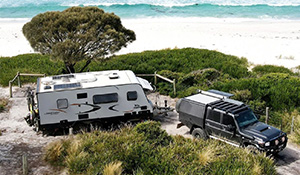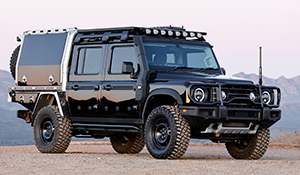Mazda previews new BT-50
Ahead of its release later this year, Mazda has presented the first images and initial details of their all-new, third-generation BT-50.
Aside from the obvious styling changes, the first all-new BT-50 since the UP/UR generation from 2011 also runs new underpinnings. While the current generation BT-50 is based on (and shares some componentry with) the Ford Ranger, the upcoming BT-50 is based on the platform of the next Isuzu D-Max. This is one of the first results of Mazda’s collaboration with Isuzu that was announced in 2016.

Beyond the new look and new platform, the upcoming BT-50 also includes a comprehensive list of advanced features to set what Mazda says is a new benchmark in the segment, all without compromising the ute’s high safety standards or rugged capability.
“The Brand-New Mazda BT-50 will bring unrivalled design, comfort and capability to the popular ute segment, raising the bar for what these customers can expect from their ute,” says Mazda Australia Managing Director Vinesh Bhindi.
“A more rugged, muscular application of Mazda’s successful Kodo design gives the Brand-New Mazda BT-50 unmistakable road presence, while the high-tech safety features provide drivers and fleet managers with peace of mind.”
Bhindi adds that the new BT-50 will also deliver a better ownership experience, thanks to a long list of accessories and customer programs that will launch closer to local release.

New Look Outside
The new BT-50’s styling is in line with the ‘Kodo’ design language applied to Mazda’s large SUVs, like the CX-8 and CX-9, with what Mazda call their “three-dimensional signature wing” treatment of the grille and front end. It’s markedly different from the current BT-50 and, at first glance, has a touch of the old Ford SZ MkII Territory in the lighting arrangement and blunter appearance of the grille.
That boxy and more muscular look continues on the flanks, with subtler side creases and wheelarch enhancement.
At the rear, the tail light configuration is completely different and actually looks closer to the first-generation BT-50 from 2006-11 in appearance.
To enhance the new styling, Mazda say they’ve developed new colours, including Gunblue Mica that features lighter blue highlight areas and darker blue in the shaded areas. Concrete Grey Mica with an aluminium flake is another newly-developed colour.

New Look Inside
Inside, the new BT-50’s appearance is just as different from the old model as the exterior. There’s a distinct horizontal approach to the dash, with the upper phone storage tray gone and the 9.0-inch centre touchscreen sitting higher, flanked by re-shaped air vents. Controls for the climate control air con have been reduced from large dials to a set of small toggle switches, with the hi-lo range selection moved up to where those dials used to be, while the traction and hill descent control switches have been shifted down to alongside the gear lever. Heat seating controls (when fitted) and the rear parking sensor control switch also flank the gear lever, which has been redesigned.
The steering wheel has had a makeover, too, with a circular boss and an ‘open’ lower spoke, inspired by the CX-8/CX-9, as well as a new look for the phone and cruise control buttons.
Analogue speedo/tacho gauges, flanking a central digital display, have been retained on the instrument panel, but this is now integrated under one hooded binnacle; part of the overall cleaner look to the cockpit.
Leather trim will feature on selected upper model grades, including the dash top and rear seats, with power adjustment on the driver’s seat, heated front seats (selected model grades only) and USB ports for rear-seat passengers. Initial impressions suggest there’s decent rear seat room, too.

New Power, Too
In line with the platform sharing arrangement with Isuzu, the new BT-50 will ditch the current 3.2-litre turbodiesel shared with Ford for a 3.0-litre turbodiesel four-cylinder from the D-Max. Outputs of 140kW and 450Nm are down on the 3.2’s 147kW and 470Nm, but up from the 130kW/430Nm offered in the current D-Max. Mazda says the reduced capacity, combined with an overall reduction in vehicle weight, will deliver a “significant improvement” in fuel economy.
Transmissions are yet to be revealed, but presumably a six-speed manual and six-speed auto will continue to be offered, as both are currently available on the D-Max. Same goes for the four-wheel drive system, but teaser images show dual-range will be part of the specification, presumably based on the ‘4x4 Terrain Command’ system in the current D-Max.
For BT-50 fans, this won’t be a major change, as six-speed autos and manuals are offered on the Mazda, as is a two-speed transfer case.
Braked towing capacity of 3,500kg and payload of up to 1,000kg are listed, but this will vary depending on model grade and body/chassis configuration.

Advanced Tech
Apart from the new styling, the biggest boast Mazda are making about the upcoming BT-50 is its range of safety and driver assistance features.
These include BT-50 firsts, like Adaptive Cruise Control, Auto Emergency Braking, Lane Keep Assist, Blind Spot Monitoring and Rear Cross Traffic Alert, all of which will be standard equipment.
Wireless Apple CarPlay and Android Auto connectivity will also feature, along with height and reach adjustment on the steering wheel. Both these elements are rare in a dual cab ute.

2020 Delivery
Mazda say the new BT-50 is due for local release “later in 2020” and may arrive after the Isuzu D-Max it was developed in tandem with.
Further details, from model range options, to full specs and pricing, will be revealed closer to release.
To see more, the official BT-50 reveal video can be viewed on Mazda Australia’s YouTube channel, with further details on: https://www.mazda.com.au/cars/brand-new-bt-50









